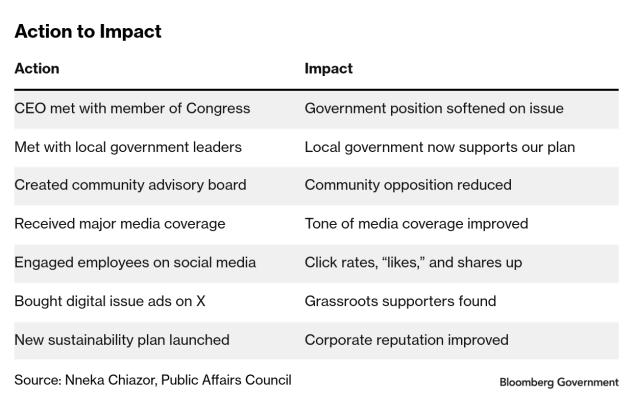“What’s the projected ROI? How will this initiative drive growth? Are we creating visible value for our customers?” These are typical questions that corporate leadership might pose to business units as they develop strategies and plans to scale products and services.
But how do you show the value of a corporate function that has an invisible connection to the bottom line; can’t be measured using classic financial, operations, and sales metrics; and might achieve its greatest success when, well, nothing happens (that irksome bill that died in committee)?
It isn’t surprising, then, that the government relations function is often viewed as a cost center. Its value rarely computes when run through a standard corporate performance management system.
This quandary government relations teams are facing is leading to a surge in demand for complex, data-driven measurement systems that makes their bottom-line contributions visible. The objectives for the function are usually long term, often involve managing risk rather than creating business opportunities, and are more susceptible to shifts from the politics and issues of the day. Not to mention that strategies are often executed in concert with coalitions, trade associations, and other third-party stakeholders. Despite this, it is possible to develop an effective measurement system for government relations and public affairs departments. Here are four strategies:
Build Around Value
Start by understanding your value proposition. Value propositions specifically define the roles of various departments in helping an organization articulate its competitive advantage. Be proactive. Don’t wait for senior management to ask for it—build it yourself.
Done well, your value proposition not only justifies your function’s existence, but ties government relations directly to the success of the business and makes clear that you’re an investment center.
The value proposition of public affairs, including government relations, may be described in a variety of ways: a watchdog against threats to reputation or a catalyst to enhance an organization’s reputation; a steward of key stakeholder relationships; or a strategic driver for unlocking market access for business.
More often than not, it’s a mix of these and other value factors, such as avoiding costs and increasing efficiency.
Speak C-Suite
Building a value proposition is step one, but it doesn’t solve the problem of fitting the square peg of government relations into the round hole of traditional business outputs. “Meeting people where they are” is a phrase we often use in public affairs that would serve us well when it comes to engaging the C-suite.
Your CFO may not understand the intricacies of a lobbying campaign or care how many lawmakers you met with, but he will appreciate avoiding additional costs from new legislation or regulations.
Your CEO may not be interested in the fine details of your issues-management process, but she will appreciate the risk management skills and social capital investments that thwarted a negative headline in the local business journal.
Start by building a metrics system that shows the overall value of the government relations function and explains it in a language that management will understand. Always try to quantify this value in dollars and cents so that executives understand the full scale of financial savings your efforts achieved (or financial harm avoided).
When possible, tie your function’s strategy and goals to overall business objectives, lean into your value proposition, and explore opportunities for collaboration outside your function.
During my time at Cox, the government and public affairs teams supported Cox Enterprises’ 34 by 34 initiative, which aims to help 34 million people live more prosperous lives by 2034 through several key pathways, including access to technology, lifelong education, employment skills, and good health. The teams amplified efforts to ensure business programs made meaningful impact on all pathways, especially “access to technology.”
Impact, Not Actions
While there may be occasions when traditional KPIs can show the value of government relations actions and campaigns, more often it’s the impact, not the action, that gets the attention of senior management. In this sense, your impact is your metric.
The following chart shows examples of how to translate actions into impacts:
Impact-focused metrics should track improvement and reflect a company’s culture. It’s also important to know when to lean into qualitative metrics, as not every policy result is easy to quantify.
Ask yourself if the number is meaningful or if you’re just running up the score. A company focused on advancing its brand or reputation may prefer qualitative analysis, such as case studies, surveys, and focus groups, to show more in-depth and nuanced understanding of complex issues.
Communicate Your Value
You’ve built your value proposition, engaged the C-suite and business units, and identified meaningful metrics that show the impact of your government relations work. Now it’s time to get the word out.
Format, tone, and platform will vary depending on your audience—senior management, employees, external stakeholders, and other groups—but what shouldn’t vary is the value you show.
Speak the language of your audience. An annual report, formal memo, or meeting might be the most effective way to communicate value to senior leadership. External stakeholders, advocates, and other audiences can be reached through action alerts and periodic updates, weekly or monthly newsletters, and social media posts. Employee communication can come in the form of Zoom meetings, corporate management tools such as Slack or Teams, and internal emails.
Remember, the more non-government relations colleagues you communicate with about your work, the more your function’s value will be perceived. Be concise by clearly describing the issue, showing the significance to the organization, and explaining the action being taken.
Your perceived cost center will soon turn into an investment center.
This article does not necessarily reflect the opinion of Bloomberg Industry Group, Inc., the publisher of Bloomberg Law, Bloomberg Tax, and Bloomberg Government, or its owners.
Author Information
Nneka Chiazor is the president and CEO of the Public Affairs Council.
Write for Us: Author Guidelines
To contact the editors responsible for this story:

